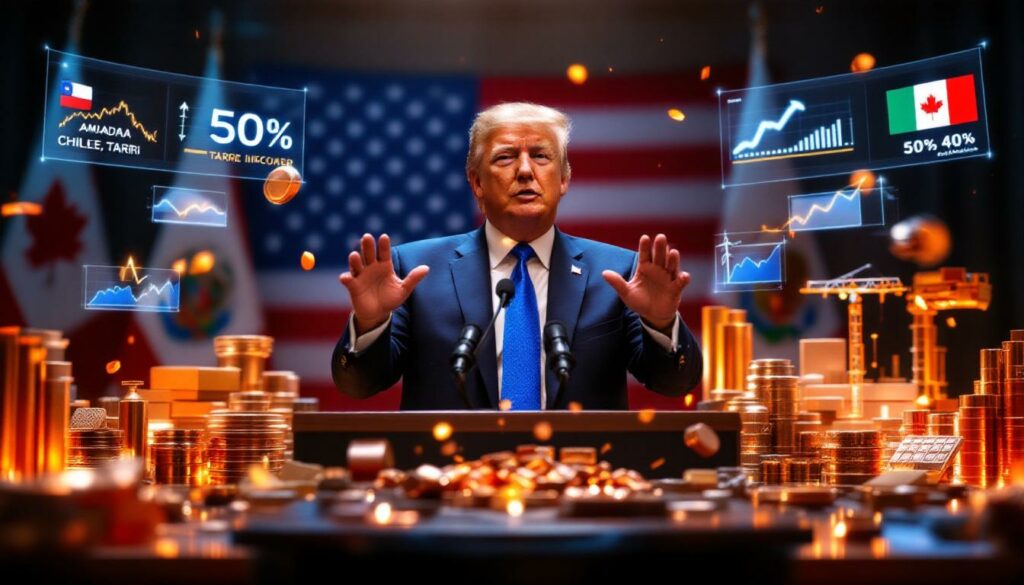How Will Trump's 50% Copper Tariff Impact Global Markets?
The announcement of a potential 50% tariff on copper imports to the United States has sent shockwaves through global commodity markets, with immediate price surges indicating significant disruption ahead. This policy represents a major shift in US trade policy toward a critical industrial metal and raises important questions about global supply chains, diplomatic relationships, and industrial competitiveness.
What is Trump's New Copper Tariff Policy?
President Donald Trump announced plans to impose a 50% tariff on copper imports during a White House cabinet meeting on July 8, 2025. The announcement triggered an immediate market reaction, with US Comex copper futures surging more than 12% to record highs, demonstrating the significant market impact of the policy.
Commerce Secretary Howard Lutnick provided additional details, indicating the tariffs could take effect "by the end of July or on August 1, 2025," creating a relatively short implementation window that increases market uncertainty.
"The idea is to bring copper home, bring copper production home, bring the ability to make copper, which is key to the industrial sector, back home to America," Lutnick stated during the announcement, clearly framing the policy as part of a broader strategy to strengthen domestic production capabilities.
Policy Development Process
The tariff announcement follows a Section 232 investigation into copper imports that began in February 2025. Under the Trade Expansion Act of 1962, Section 232 allows the president to adjust imports if they are determined to threaten national security.
What's unusual in this case is the timeline. According to Commerce Secretary Lutnick, the review has already been completed, despite having a November 2025 deadline for conclusion. This expedited process suggests a predetermined policy direction and urgent implementation timeline.
Strategic Objectives
The administration has positioned this tariff as essential for enhancing America's industrial self-reliance and national security. The 50% tariff rate—matching recent tariffs impact on ASX copper stocks—represents a significant barrier designed to fundamentally reshape supply chains rather than make minor market adjustments.
The National Mining Association has declined to comment until more details are disclosed, indicating even industry stakeholders are analyzing the potential implications of this sudden policy shift.
Why Is Copper Strategically Important?
Copper's unique combination of electrical conductivity, corrosion resistance, and versatility makes it irreplaceable in numerous critical applications. While gold and silver offer superior conductivity, copper's significantly lower cost makes it the practical choice for mass industrial applications.
Economic and Industrial Significance
Copper serves as a fundamental material across multiple industries, with applications ranging from electrical wiring and electronics to plumbing, transportation, and renewable energy infrastructure. Its exceptional conductivity makes it essential for power transmission and electronic devices, while its corrosion resistance provides durability for water systems and exposed architectural elements.
The metal is often referred to as "Dr. Copper" in financial markets due to its ability to predict economic trends—when demand for copper rises, it typically signals expanding industrial activity and economic growth.
National Security Considerations
The Section 232 investigation framework specifically examines imports from a national security perspective. Copper's critical role in defense applications—including naval vessels, aircraft, communications equipment, and weapons systems—makes it strategically important for national security planning.
Modern warfare increasingly depends on electronics and communication systems where copper remains irreplaceable. Additionally, the power grid infrastructure necessary for national resilience relies heavily on copper conductors and transformers.
Supply Chain Vulnerabilities
The United States currently imports approximately half of its copper requirements annually, creating significant supply chain vulnerability. This dependency is particularly concerning given increasing resource nationalism in major copper-producing regions and the concentration of production in a small number of countries.
Chile, Canada, and Mexico are the top suppliers of refined copper and copper products to the United States according to US Census Bureau data cited by Mining Technology. This concentration of supply sources increases vulnerability to geopolitical disruptions or trade disputes.
What Will Be the Economic Impact of the Tariff?
The 50% tariff represents a transformative economic intervention that will reshape market dynamics across multiple industries and regions. Its effects will likely cascade throughout supply chains, affecting everything from mining investments to consumer goods pricing.
Market Price Reactions
The immediate 12% surge in copper futures following the announcement signals significant market recalibration. This price response reflects both the direct impact of the tariff and market speculation about longer-term supply chain adjustments.
The price increase could have cascading effects through manufacturing supply chains. Industries that rely heavily on copper—including construction, electronics, and renewable energy—face potentially significant cost increases that may be passed along to consumers or absorbed through reduced profit margins.
Domestic Production Incentives
The substantial 50% tariff creates powerful economic incentives for expanding domestic copper mining and processing operations. Currently operating US copper mines in Arizona, Utah, New Mexico, and Nevada may accelerate expansion plans, while marginal operations that were previously economically unviable could become profitable under the new tariff protection.
"The idea is to bring copper home, bring copper production home, bring the ability to make copper, which is key to the industrial sector, back home to America," – Commerce Secretary Howard Lutnick
However, developing new copper mining capacity requires significant capital investment and lengthy permitting processes. Even with strong price incentives, domestic supply cannot increase immediately, creating a transition period with higher prices and potential supply constraints.
International Trade Disruptions
The tariff will significantly disrupt established trade patterns, particularly affecting major copper exporters to the US market. This could lead to trade diversion, with copper supplies being redirected to alternative markets such as China and Europe, potentially creating regional price disparities.
Countries heavily dependent on the US market for their copper exports may face economic hardship in mining regions until alternative buyers can be secured. This could trigger diplomatic tensions and potentially lead to retaliatory measures against US exports.
Which Countries Will Be Most Affected?
The impact of the tariff will vary significantly based on countries' export exposure to the US market and their ability to redirect shipments to alternative buyers.
Primary US Copper Suppliers
According to US Census Bureau data cited by Mining Technology, Chile, Canada, and Mexico are the top suppliers of refined copper and copper products to the United States in 2024. These countries will face the most direct impact from the new tariff policy.
Chile, as the world's largest copper producer and a major US supplier, faces significant exposure to the tariff. The country's economy relies heavily on copper exports, making market disruptions particularly challenging.
Canada and Mexico, as USMCA partners with integrated supply chains, face both direct tariff impacts and broader implications for continental manufacturing networks.
Free Trade Agreement Considerations
Canada, Mexico, Chile, and Peru have argued their exports should be exempt from the tariffs due to existing free trade agreements with the United States. These countries maintain that their copper exports do not threaten US national security interests, which is the ostensible justification for the Section 232 investigation.
The decision to include or exempt these nations will have significant diplomatic implications beyond the copper market itself. Applying tariffs despite free trade agreements could undermine confidence in these agreements and potentially trigger retaliatory measures.
Canadian Metal Industry Challenges
The Canadian metals industry is already struggling with the effects of higher US tariffs on Canadian industries, which were recently increased to 50%. Industry representatives have warned about potential job losses and reduced sales resulting from these trade barriers.
Adding copper to the list of tariffed metals would compound these challenges for Canadian producers, potentially forcing significant restructuring of the North American metals industry. Communities dependent on mining and metal production could face particular economic hardship.
How Might Global Copper Markets Adapt?
Markets typically find ways to adapt to trade barriers over time, though often with increased costs and inefficiencies. The copper market will likely experience several phases of adjustment in response to the tariff.
Supply Chain Restructuring
The significant tariff barrier will likely trigger supply chain restructuring as manufacturers seek to minimize cost impacts. This could include:
- Relocating processing operations to the US to avoid tariffs
- Developing alternative sourcing strategies
- Creating more regionalized supply networks
- Accelerating material substitution where technically feasible
- Implementing copper recycling and recovery programs
Companies with flexible global operations may adjust their production networks to process copper within the US while sourcing raw materials internationally. This would allow them to avoid tariffs while maintaining access to global copper resources.
Price Arbitrage Opportunities
The substantial tariff differential may create price arbitrage opportunities between US and global markets. Traders and intermediaries could develop strategies to capitalize on these price disparities through various mechanisms:
- Transshipment through countries not subject to tariffs (if any exemptions exist)
- Value-added processing to change product classification
- Contract restructuring to optimize tariff treatment
- Development of swap arrangements between related entities
These arbitrage activities may partially mitigate price impacts but add complexity and transaction costs to the global copper market.
Investment Shifts in Mining Sector
The tariff protection could redirect investment capital toward US copper mining projects that previously struggled to compete with lower-cost international operations. This may accelerate domestic exploration, mine development, and processing capacity expansion.
International mining companies may reconsider their project portfolios, potentially delaying investments in countries heavily dependent on US export markets. Capital may shift toward projects serving alternative markets like China, Europe, and emerging Asian economies.
What Are the Potential Challenges to Implementation?
Despite the administration's apparent determination to implement the tariffs quickly, several significant challenges could affect the timing, scope, or ultimate success of the policy.
Legal and Trade Agreement Challenges
Countries with free trade agreements with the US may challenge the tariffs through dispute resolution mechanisms specified in those agreements. The USMCA (with Canada and Mexico) and bilateral agreements with Chile and Peru all contain provisions governing the application of tariffs and national security exceptions.
The compatibility of the copper tariffs with World Trade Organization (WTO) rules could also face scrutiny and potential legal challenges. Previous Section 232 tariffs on steel and aluminum faced similar challenges, creating precedents that may apply to the copper case.
Industry Response Uncertainty
While the National Mining Association has declined to comment until more details are disclosed, industry stakeholders will likely have varied responses based on their position in the supply chain. Mining companies may welcome the protection, while copper-consuming manufacturers might strongly oppose the potential cost increases.
Industry coalitions on both sides of the issue will likely mobilize to influence implementation details, potentially seeking exemptions for specific products or countries. This lobbying could affect the final form of the tariffs.
Political and Diplomatic Considerations
The tariff implementation could face diplomatic pushback from affected countries, potentially leading to retaliatory measures against US exports. This dynamic could complicate bilateral relations with key trading partners and allies.
Given the strategic importance of relationships with Canada and Mexico in particular, diplomatic considerations may ultimately influence the final implementation of the tariffs, potentially leading to exemptions or modifications.
How Will This Impact Copper-Dependent Industries?
Industries that rely heavily on copper inputs will face varying degrees of impact based on their ability to pass along cost increases, substitute materials, or adjust supply chains.
Construction Sector Effects
The construction industry, a major copper consumer for electrical wiring, plumbing, and architectural applications, could face increased material costs. This may affect project budgets and potentially slow development in price-sensitive segments of the market.
Residential construction is particularly vulnerable to copper price increases, as wiring, plumbing, and HVAC systems represent significant components of building costs. Commercial construction projects may face budget pressures or design modifications to reduce copper intensity.
Electronics and Technology Manufacturing
Electronics manufacturers rely heavily on copper for components, circuit boards, and wiring. Higher input costs could pressure profit margins or necessitate price increases for consumer electronics and technology products.
The semiconductor industry, already facing supply chain challenges, may experience additional cost pressures from higher copper prices. This could potentially affect the cost of computing equipment, telecommunications infrastructure, and consumer devices.
Renewable Energy Development
Copper is essential for renewable energy infrastructure, including solar panels, wind turbines, and energy storage systems. A typical utility-scale solar installation requires approximately 5.5 tons of copper per megawatt, while wind power installations use roughly 2.5-6.5 tons per megawatt.
The tariff could potentially increase costs for clean energy projects, affecting deployment rates and investment returns. This may create tension with other policy priorities aimed at accelerating renewable energy adoption and reducing carbon emissions.
What Are the Potential Global Market Responses?
Beyond immediate price reactions, the tariff may trigger broader strategic responses from international market participants seeking to mitigate impacts or capitalize on new opportunities.
Alternative Market Development
Countries affected by US tariffs may accelerate efforts to develop alternative markets for their copper exports, potentially strengthening trade relationships with China, Europe, and emerging economies in Asia.
Chile, with its heavy dependence on copper exports, may pursue more aggressive trade agreements with Asian economies to offset lost US market access. Similarly, Canadian and Mexican producers may look to diversify their customer base beyond North America.
Production Capacity Adjustments
Global copper miners may recalibrate production plans and investment strategies in response to changing market dynamics. This could include postponing expansion projects in countries heavily dependent on US export markets.
International mining companies may also pursue vertical integration strategies, investing in downstream processing and manufacturing to capture more value and reduce exposure to raw material tariffs.
Price Stabilization Mechanisms
Industry associations and affected countries might explore mechanisms to stabilize copper markets and mitigate price volatility resulting from the tariff shock. This could include coordinated production adjustments or strategic stockpile management.
Large copper consumers outside the US may take advantage of redirected supply to negotiate more favorable pricing or long-term supply agreements, potentially creating regional price advantages for their manufacturing sectors.
What Questions Remain Unanswered?
Despite the significant market reaction to the tariff announcement, many critical details remain unclear, creating uncertainty for market participants and affected countries.
Implementation Details and Exemptions
The full details of the tariff implementation, including potential country-specific or product-specific exemptions, remain unclear. These details will significantly influence the actual market impact and industry response.
Key questions include whether free trade agreement partners will receive exemptions, whether different forms of copper (ore, concentrate, refined, semi-fabricated) will face different tariff rates, and what certification or origin documentation will be required.
Duration and Review Mechanisms
The announcement did not specify whether the tariffs would include sunset provisions or regular review mechanisms to assess their effectiveness and continued necessity.
Without clear timelines for review, market participants face uncertainty about long-term investment decisions and supply chain restructuring. This uncertainty could lead to hesitancy in major capital commitments by both mining companies and copper-consuming industries.
Downstream Policy Support
Questions remain about whether the administration will implement complementary policies to support downstream copper-consuming industries that may face higher input costs as a result of the tariffs.
Without such support, the tariffs could have unintended consequences for US manufacturing competitiveness in global markets. Balancing the interests of domestic copper producers and copper-consuming industries represents a significant policy challenge.
FAQs About Trump's Copper Tariff
When will the 50% copper tariff take effect?
According to Commerce Secretary Howard Lutnick, the tariffs could be implemented by the end of July or August 1, 2025, though an official implementation date has not been confirmed.
Which countries export the most copper to the United States?
Chile, Canada, and Mexico are currently the top suppliers of refined copper and copper products to the US market, according to US Census Bureau data cited by Mining Technology.
Will countries with free trade agreements be exempt from the tariffs?
This remains unclear. Canada, Mexico, Chile, and Peru have argued they should be exempt due to existing free trade agreements, but the administration has not announced any exemptions as of the initial announcement.
How dependent is the US on copper imports?
The United States imports approximately half of its annual copper requirements, making it significantly dependent on foreign sources for this critical metal.
What is a Section 232 investigation?
A Section 232 investigation examines the effect of imports on national security under the Trade Expansion Act of 1962, allowing the president to adjust imports through tariffs if they are determined to threaten national security.
How did copper prices react to the tariff announcement?
US Comex copper futures surged more than 12% to a record high immediately following the announcement, demonstrating the significant market impact of the policy. These dramatic market movements have led analysts to revise their copper price predictions upward, with some suggesting sustained higher prices in the US market.
Furthermore, the tariff investment impact is expected to be substantial across various sectors, particularly affecting companies with significant exposure to copper supply chains. Investment analysts are carefully monitoring how these changes might affect the global copper supply forecast and long-term pricing trends.
Disclaimer: This article discusses potential market impacts and policy developments that may evolve as implementation details emerge. Investors and industry stakeholders should conduct thorough research and consult financial advisors before making decisions based on these tariff developments.
Want to Stay Ahead of Major Mineral Discoveries?
Discover significant market opportunities before they go mainstream with Discovery Alert's proprietary Discovery IQ model, delivering real-time alerts on potentially transformative ASX mineral discoveries. Explore our dedicated discoveries page to see how early identification of breakthrough finds can lead to exceptional investment returns.




